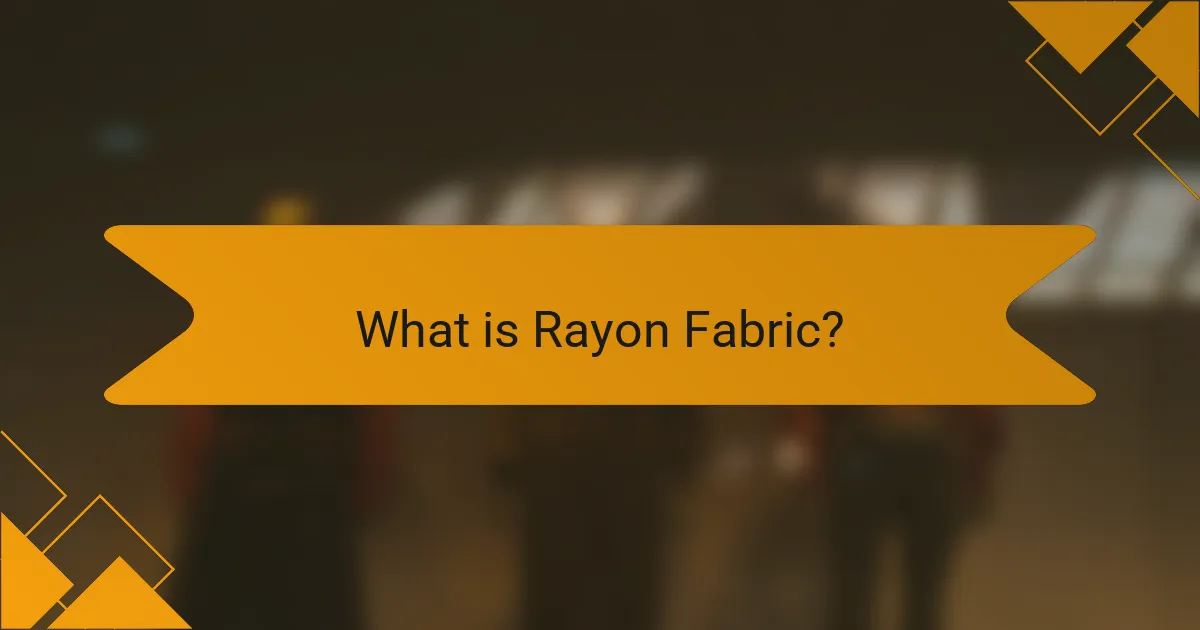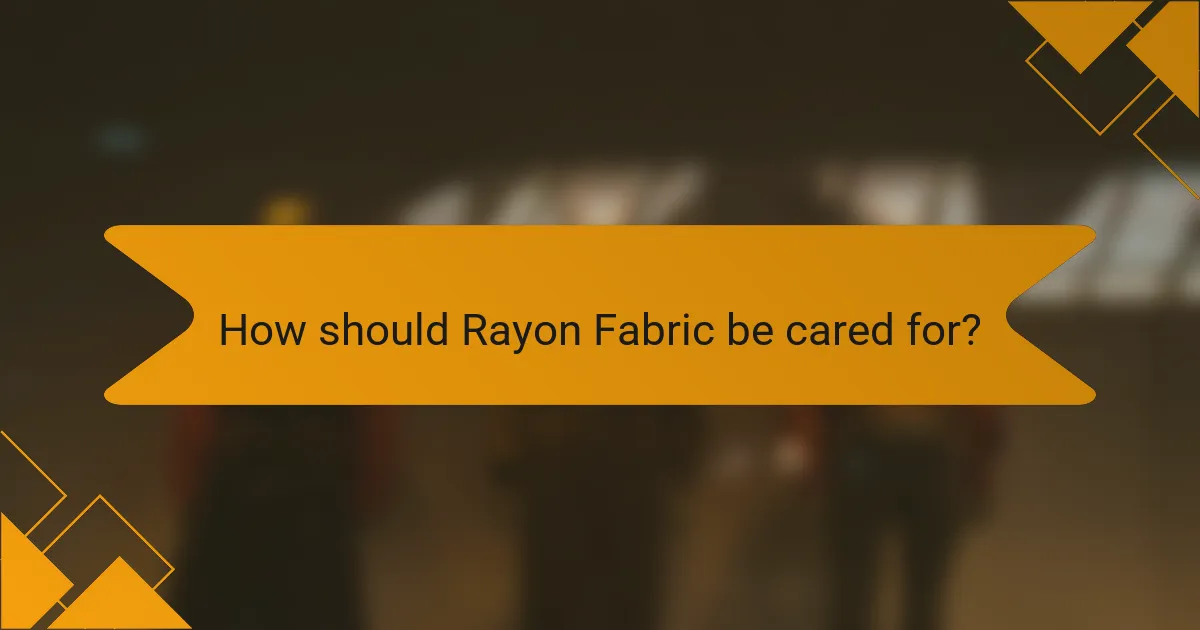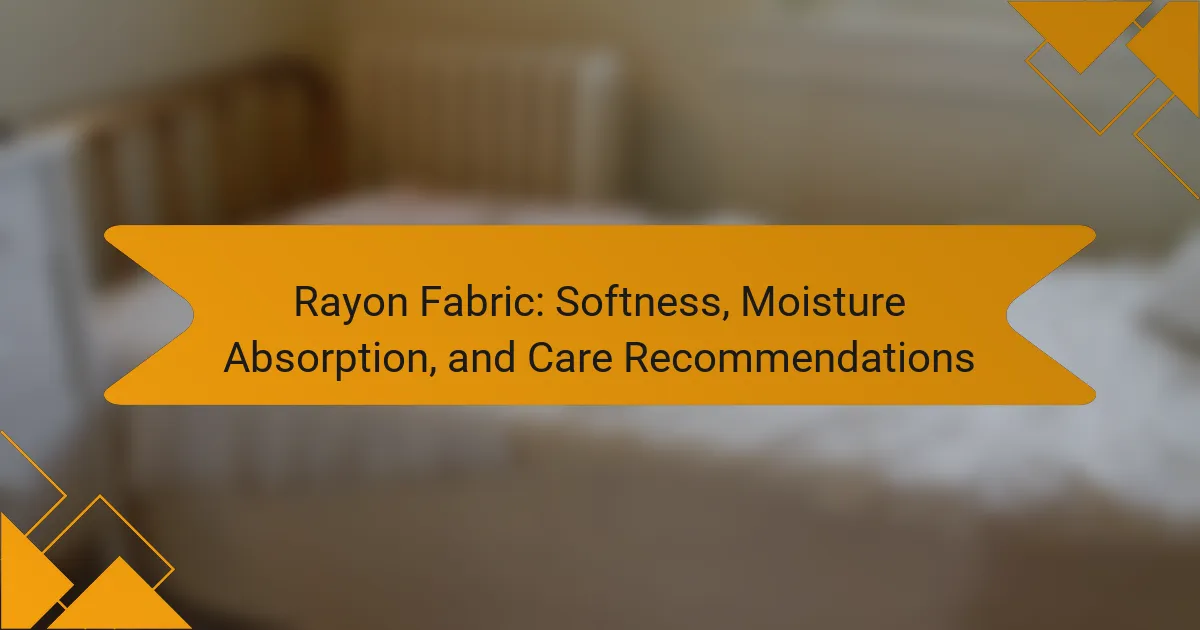Rayon fabric is a semi-synthetic textile created from regenerated cellulose fibers sourced from wood pulp. Known for its softness, drape, and excellent moisture absorption properties, rayon is commonly used in clothing items such as dresses and blouses. The article provides detailed care recommendations to maintain the fabric’s quality, emphasizing gentle washing and low-heat drying methods. It also addresses common misconceptions about rayon, clarifying its natural origins, durability, and environmental impact, while highlighting the importance of sustainable practices in its production.

What is Rayon Fabric?
Rayon fabric is a semi-synthetic textile made from regenerated cellulose fibers. It is derived from natural sources like wood pulp. Rayon is known for its softness and drape, making it popular in clothing. The fabric has good moisture absorption properties, which enhances comfort. It is often used in dresses, blouses, and linings. Rayon can mimic the feel of silk, wool, or cotton. Its versatility allows for various blends with other fibers. The production process involves treating cellulose with chemicals to create the fibers.
How is Rayon Fabric made?
Rayon fabric is made through a process that involves the transformation of cellulose. Cellulose is derived from wood pulp or cotton linters. The cellulose is chemically treated to create a viscous solution known as viscose. This viscose solution is then extruded through spinnerets to form filaments. The filaments are solidified in a chemical bath, creating rayon fibers. These fibers are then spun into yarns and woven or knitted into fabric. The entire process requires careful control of temperature and chemical concentrations to ensure quality. Rayon is known for its softness and moisture absorption properties, making it a popular choice in textiles.
What are the raw materials used in Rayon Fabric production?
Rayon fabric is primarily produced from cellulose, which is derived from wood pulp. This wood pulp is processed through a series of chemical treatments. Common sources of wood pulp include trees such as beech, pine, and eucalyptus. The cellulose is then dissolved in a solvent to create a viscous solution. This solution is extruded through spinnerets to form fibers. These fibers are then regenerated through a process that solidifies them into rayon. The use of natural cellulose makes rayon biodegradable and contributes to its soft texture.
What processes are involved in converting raw materials to Rayon Fabric?
The processes involved in converting raw materials to Rayon Fabric include several key steps. First, cellulose is extracted from wood pulp or cotton. This cellulose is then dissolved in a solvent to create a viscous solution. Next, the solution is forced through spinnerets to form filaments. These filaments are then solidified through a coagulation process in a spinning bath. After solidification, the filaments are washed, bleached, and dried. Finally, the dried filaments are cut into staple fibers or wound into spools for weaving. This process transforms raw cellulose into the soft, absorbent Rayon fabric used in textiles.
What are the characteristics of Rayon Fabric?
Rayon fabric is known for its softness and comfort. It has a smooth texture that feels gentle against the skin. Rayon is highly absorbent, making it ideal for warm weather. It can wick moisture away from the body effectively. The fabric drapes well, giving garments an elegant appearance. Rayon is also breathable, allowing air circulation. However, it can shrink when washed improperly. Additionally, rayon may wrinkle easily, requiring careful handling.
How does the softness of Rayon Fabric compare to other fabrics?
Rayon fabric is known for its exceptional softness, often surpassing cotton and polyester. Its smooth texture is a result of the fiber’s semi-synthetic nature. Rayon is made from regenerated cellulose, which contributes to its luxurious feel. In comparison, cotton is softer than many synthetic fabrics but not as smooth as rayon. Polyester, while durable, typically lacks the softness that rayon offers. Studies show that rayon is frequently preferred for clothing due to its gentle touch against the skin. This softness makes rayon ideal for garments like dresses and blouses. Overall, rayon fabric stands out for its superior softness compared to other common fabrics.
What factors contribute to the moisture absorption properties of Rayon Fabric?
Rayon fabric’s moisture absorption properties are influenced by its chemical composition and fiber structure. The cellulose content in rayon allows it to absorb moisture effectively. Rayon fibers have a high degree of crystallinity, which enhances their ability to wick moisture away from the skin. Additionally, the porous nature of rayon fibers contributes to their moisture-retaining capabilities. Studies show that rayon can absorb up to 50% of its weight in moisture. This property makes rayon suitable for clothing in humid conditions. The manufacturing process also affects moisture absorption, as treatments can modify the fiber’s surface characteristics.
What are the benefits of using Rayon Fabric?
Rayon fabric offers several benefits, including softness, breathability, and moisture absorption. Its smooth texture makes it comfortable against the skin. Rayon is also lightweight, which enhances its wearability in warm climates. The fabric has excellent moisture-wicking properties, drawing sweat away from the body. This helps keep the wearer dry and comfortable. Additionally, rayon can mimic the feel of silk or cotton, providing versatility in fashion. Its ability to drape well makes it suitable for various clothing styles. Rayon is also easy to dye, allowing for vibrant colors and patterns. These attributes make rayon a popular choice in the textile industry.
How does Rayon Fabric enhance comfort in clothing?
Rayon fabric enhances comfort in clothing through its softness and moisture-wicking properties. The fibers of rayon are smooth, which allows for a gentle touch against the skin. This softness reduces friction, making garments more comfortable to wear for extended periods. Additionally, rayon has excellent moisture absorption capabilities. It can absorb up to 50% more moisture than cotton, keeping the wearer dry and comfortable. This quality helps regulate body temperature, especially in warm conditions. Rayon also drapes well, providing a flattering fit without constricting movement. These attributes collectively contribute to the overall comfort of rayon clothing.
What environmental considerations are associated with Rayon Fabric production?
Rayon fabric production has several environmental considerations. The process involves using wood pulp, primarily sourced from trees, leading to deforestation concerns. The chemicals used in processing, such as sodium hydroxide and carbon disulfide, can cause air and water pollution. Wastewater from rayon production can be toxic to aquatic life if not properly treated. Additionally, the energy-intensive production process contributes to greenhouse gas emissions. Sustainable practices, like sourcing from responsibly managed forests and using closed-loop systems, can mitigate some of these impacts.

How should Rayon Fabric be cared for?
Rayon fabric should be cared for with gentle washing and proper drying. Hand washing is preferred to maintain its softness. Use cold water and a mild detergent to avoid damage. Machine washing is possible but should be on a delicate cycle. Avoid bleach, as it can weaken the fibers. Air drying is recommended to prevent shrinkage. If using a dryer, select a low heat setting. Iron on a low setting while the fabric is slightly damp to remove wrinkles. These care methods help preserve the fabric’s quality and longevity.
What washing methods are recommended for Rayon Fabric?
Hand washing is the recommended method for cleaning rayon fabric. This method helps prevent damage to the fibers. Use cold water and a mild detergent specifically designed for delicate fabrics. Gently agitate the fabric without wringing or twisting it. Rinse thoroughly to remove all detergent. If machine washing is necessary, use a gentle cycle with cold water. Place the rayon item in a mesh laundry bag to protect it. Avoid bleach and fabric softeners, as they can harm the fabric. Always air dry rayon items; do not use a dryer, as heat can cause shrinkage.
How can one prevent shrinkage when washing Rayon Fabric?
To prevent shrinkage when washing rayon fabric, wash it in cold water. Hot water can cause rayon to shrink significantly. Use a gentle cycle to minimize agitation. Avoid wringing or twisting the fabric, as this can distort its shape. Instead, lay the fabric flat to dry or hang it to avoid stretching. Additionally, consider using a mesh laundry bag for added protection. Rayon is sensitive to heat; therefore, do not use a dryer. Following these steps can help maintain the fabric’s size and shape.
What detergents are best suited for Rayon Fabric care?
Mild detergents are best suited for rayon fabric care. These detergents help maintain the softness and integrity of the fibers. Look for products labeled as gentle or designed for delicate fabrics. Brands such as Woolite and Ecover offer formulations specifically for rayon. Avoid bleach and harsh chemicals, as they can damage the fabric. Cold water washing is recommended to prevent shrinkage. Always check the care label on rayon garments for specific instructions. Using the right detergent ensures the longevity of rayon items.
How should Rayon Fabric be dried?
Rayon fabric should be dried by laying it flat on a clean, dry surface. This method prevents stretching and maintains the fabric’s shape. Avoid hanging rayon, as it can lead to distortion. If using a dryer, select a low heat setting. High heat can damage rayon fibers. Always check care labels for specific drying instructions. Rayon is sensitive to heat, which can cause shrinkage. Following these drying methods preserves the quality of the fabric.
What drying techniques should be avoided with Rayon Fabric?
Avoid using high heat when drying rayon fabric. High heat can cause rayon to shrink or become damaged. Air drying is recommended instead. Avoid tumble drying as it can lead to excessive wrinkling. Do not wring or twist rayon fabric to remove excess water. This can distort its shape and texture. Instead, gently press the fabric between towels to absorb moisture. These techniques help maintain the integrity of rayon fabric.
How can you safely iron Rayon Fabric without causing damage?
To safely iron rayon fabric without causing damage, use a low heat setting. Rayon is sensitive to high temperatures, which can lead to scorching or melting. Place a thin cloth or pressing cloth between the iron and the fabric. This additional layer protects the rayon from direct heat. Always iron the fabric while it is slightly damp. This method helps to relax the fibers and reduce the risk of damage. Avoid using steam directly on rayon, as it can create water spots or distort the fabric. Instead, lightly mist the fabric with water if it is too dry. Following these guidelines ensures that rayon maintains its quality and appearance.

What are common misconceptions about Rayon Fabric?
Common misconceptions about rayon fabric include the belief that it is a synthetic material. In reality, rayon is a semi-synthetic fiber made from natural cellulose sources like wood pulp. Another misconception is that rayon is not absorbent. In fact, rayon has excellent moisture absorption properties, making it comfortable to wear in warm weather. Some people think rayon is not durable. However, when cared for properly, rayon can be quite durable. Additionally, many believe that rayon is difficult to care for. While it may require special washing and drying methods, it is manageable with proper instructions. Lastly, there is a misconception that rayon is environmentally harmful. Although the production process can impact the environment, sustainable practices are being adopted in the industry.
Is Rayon Fabric environmentally friendly?
Rayon fabric is not considered environmentally friendly. The production of rayon involves the use of harmful chemicals, such as sodium hydroxide and carbon disulfide. These chemicals can pollute water sources and pose health risks to workers. Additionally, rayon is derived from trees, primarily from forests that may be unsustainably harvested. This can lead to deforestation and loss of biodiversity. Some manufacturers are adopting more sustainable practices, but the overall impact of rayon production remains concerning.
What are the myths surrounding the durability of Rayon Fabric?
Myths surrounding the durability of Rayon fabric include the belief that it is weak and easily damaged. Many people think Rayon cannot withstand regular wear and tear. In reality, Rayon can be quite durable when properly cared for. It is important to note that Rayon is made from natural fibers, which can lead to misconceptions about its strength. When compared to synthetic fabrics, Rayon may show wear faster if not maintained correctly. However, with appropriate washing and care, Rayon can last a long time. Additionally, some believe that Rayon is not suitable for everyday use. This is untrue, as many garments made from Rayon are designed for durability and comfort.
How can you troubleshoot issues with Rayon Fabric?
To troubleshoot issues with rayon fabric, first identify the specific problem. Common issues include shrinking, fading, and wrinkling. If the fabric shrinks, wash it in cold water and air dry. This method helps maintain its size. For fading, avoid prolonged exposure to direct sunlight. Store rayon in a cool, dark place. To address wrinkling, use a low-heat iron or steam the fabric gently. Rayon is prone to wrinkles, so proper storage can minimize this. Additionally, always follow care instructions on the label for best results. These troubleshooting steps are effective based on the properties of rayon fabric, which is known for its delicate nature.
What should you do if Rayon Fabric shrinks after washing?
To unshrink rayon fabric, soak it in lukewarm water mixed with baby shampoo or conditioner. This method relaxes the fibers. After soaking for about 30 minutes, gently stretch the fabric back to its original size. Rinse the fabric in cool water to remove the solution. Lay it flat on a towel to dry, reshaping it as needed. Rayon is prone to shrinking due to its fiber structure, which reacts to heat and moisture. Following these steps can help restore the fabric’s size effectively.
How can you remove stains from Rayon Fabric effectively?
To remove stains from rayon fabric effectively, act quickly to treat the stain. Blot the stain gently with a clean cloth to absorb excess liquid. Use cold water to rinse the stained area. Prepare a solution of mild detergent and water. Apply the solution to the stain using a soft cloth. Gently rub the fabric to lift the stain. Rinse the area with cold water to remove detergent. Allow the fabric to air dry completely. Avoid using bleach, as it can damage rayon.
Rayon fabric is a semi-synthetic textile made from regenerated cellulose fibers, primarily sourced from wood pulp. Known for its softness, moisture absorption, and versatility, rayon is commonly used in clothing such as dresses and blouses. The article covers the production process of rayon, its characteristics, benefits, and environmental considerations, along with care recommendations to maintain its quality. It also addresses common misconceptions about rayon’s durability and environmental impact, providing practical advice for troubleshooting issues like shrinking and staining.


